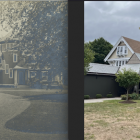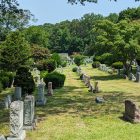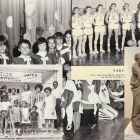
Taking a step away from “downtown” New Canaan for a week, the subject of this article is more hidden than our usual Then & Now buildings. But for those who attend the First Presbyterian Church, or those who explore the Nature Center with keen eyes, the main house of the Lindenfield Estate is probably familiar. The history of Lindenfield, or the Bliss Estate, begins in 1875 when Osborn E. Bright, an attorney from Brooklyn, bought eight acres of land on Oenoke Ridge from Joseph Fitch Silliman and built his summer residence. When finished, the new house stood very close to the neighbor’s cow barn, so close in fact that Bright’s wife, Maria, offered to build the neighbors a new barn if they would tear down the existing one. A new barn could also not be built within 100 feet of the Brights’ land. At the same time, the Brights also bought a piece of land from the same neighbor for $200. Probably a deal too good to pass up on, the old barn was torn down and a new one built out of smelling distance. In 1899, the property was sold to Miss Catherine A. Bliss from New York City for $22,500. Over the next thirteen years, Miss Bliss expanded the house and improved the grounds. A full wing was added along with a large living room and a porch. The living room was so large that it was able to fit a thirty six foot rug, which was said to have been the second largest rug ever woven in America at the time. The house built by the Brights would eventually become a hall and a dining room with bedrooms on the second floor. A farmer’s cottage was built along with a cow barn, a laundry, a grapery, a heated greenhouse, and a potting shed. To compliment all of this new construction, the property was lavishly landscaped with various rare trees and shrubs. Wetlands behind the house were drained so that flowerbeds could be installed as well. The stone wall along Oenoke was repaired and an entrance was installed. Because the driveway was lined with linden trees, the estate was named “Lindenfield.” Miss Bliss had an active social life in New Canaan and New York City. She was a member of Grace Church and helped it purchase 140 acres on Ponus Ridge. The house and the property became Grace-in-the-Fields, a retreat for underprivileged mothers and children to vacation, and is now the New Canaan Country School. When Miss Bliss passed away in 1916, the property was inherited by her niece, Susan Dwight Bliss. Susan, like her aunt, was also a summer resident, but still managed to be a great benefit to the town. During WWI she had a large vegetable garden planted on her property to help the war effort. When the Great Depression swept through New Canaan, she employed over 200 workers on various jobs around her estate. Bliss was also an avid collector of rocks from her frequent trips and had a special octagonal building constructed to hold her collection.





